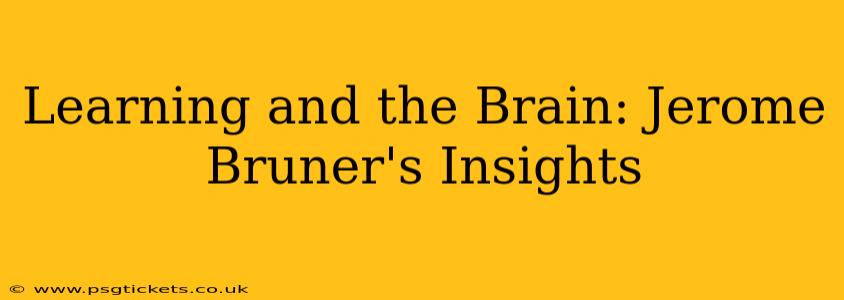Jerome Bruner, a towering figure in cognitive psychology, significantly impacted our understanding of how the brain learns. His theories, developed over decades of research, continue to resonate with educators and psychologists today. This exploration delves into Bruner's key contributions, examining how his ideas revolutionized our approach to learning and teaching. We'll explore his concepts of discovery learning, scaffolding, and the importance of narrative, revealing their enduring relevance in modern educational practices.
What are Bruner's Key Ideas About Learning?
Bruner's work centers on the idea that learning is an active process, not a passive reception of information. He emphasized the learner's role in constructing knowledge through exploration and interaction with their environment. His key contributions include:
-
Discovery Learning: Bruner championed discovery learning, believing students learn best by actively exploring concepts and formulating their own understandings. This contrasts with rote learning, where information is passively absorbed. He argued that discovery fosters deeper understanding and greater retention.
-
Spiral Curriculum: Bruner advocated for a spiral curriculum, where core concepts are revisited throughout a student's education, each time with increasing complexity and depth. This approach builds upon prior knowledge, allowing students to gradually master intricate ideas.
-
Scaffolding: This involves providing temporary support to learners as they tackle challenging tasks. The support is gradually removed as the learner gains proficiency, encouraging independence and self-reliance. Think of it like building scaffolding around a building under construction; it's essential for the process but eventually removed once the structure is complete.
-
Narrative: Bruner highlighted the importance of narrative in learning and knowledge construction. He argued that stories provide a framework for organizing information and making it more meaningful and memorable. Learning through storytelling engages the emotional and cognitive aspects of the brain, leading to deeper comprehension.
What is Bruner's Theory of Cognitive Growth?
Bruner's theory emphasizes three modes of representation in cognitive development:
-
Enactive Representation (0-1 year): Knowledge is acquired through actions and motor skills. Infants learn about the world by interacting with it physically.
-
Iconic Representation (1-6 years): Knowledge is represented through images and visual symbols. Children begin to use mental images and pictures to understand and remember information.
-
Symbolic Representation (7+ years): Knowledge is represented through language and abstract symbols. Children develop the ability to use abstract symbols, such as words and numbers, to represent concepts.
This progression isn't rigid; children may use multiple modes simultaneously. However, understanding these modes helps educators tailor their teaching methods to match the learner's developmental stage.
How Does Bruner's Work Influence Education Today?
Bruner's influence on education is profound and enduring. His emphasis on active learning, discovery, and the importance of prior knowledge underpins many modern pedagogical approaches. His ideas are evident in:
-
Inquiry-based learning: This learner-centered approach encourages students to investigate questions and construct knowledge through exploration.
-
Project-based learning: Students engage in complex projects that require them to apply their knowledge and skills in real-world contexts.
-
Differentiated instruction: Educators adapt their teaching to meet the diverse needs of their students, recognizing that learners progress at different paces and through different modes of representation.
What are the Criticisms of Bruner's Theories?
While highly influential, Bruner's work has faced some criticism. Some argue that:
-
Discovery learning can be inefficient: Students may struggle to discover concepts independently, requiring more guidance than Bruner initially suggested.
-
Scaffolding requires skilled teachers: Effective scaffolding necessitates teachers who can accurately assess student needs and provide appropriate support.
-
The spiral curriculum can be challenging to implement: Revisiting concepts repeatedly requires careful planning and coordination across grade levels.
How does Bruner's theory relate to constructivism?
Bruner's work aligns strongly with constructivist learning theories. Constructivism emphasizes the active role of the learner in building knowledge, a core principle in Bruner's approach. Both emphasize the importance of prior knowledge, social interaction, and the learner's construction of meaning.
What are the Implications of Bruner's Work for Teachers?
Bruner's insights provide valuable guidance for educators. Teachers should strive to:
-
Create active learning environments: Encourage student exploration, questioning, and problem-solving.
-
Use a variety of teaching methods: Cater to different learning styles and modes of representation.
-
Provide appropriate scaffolding: Offer support as needed, gradually releasing responsibility to students.
-
Integrate narrative and storytelling: Use stories to make learning more engaging and memorable.
Jerome Bruner's contributions to our understanding of learning and the brain are immeasurable. His ideas continue to inspire educators to create dynamic and effective learning experiences that empower students to actively construct their own knowledge. By understanding and applying his key principles, educators can foster a deeper and more meaningful learning process for all students.

